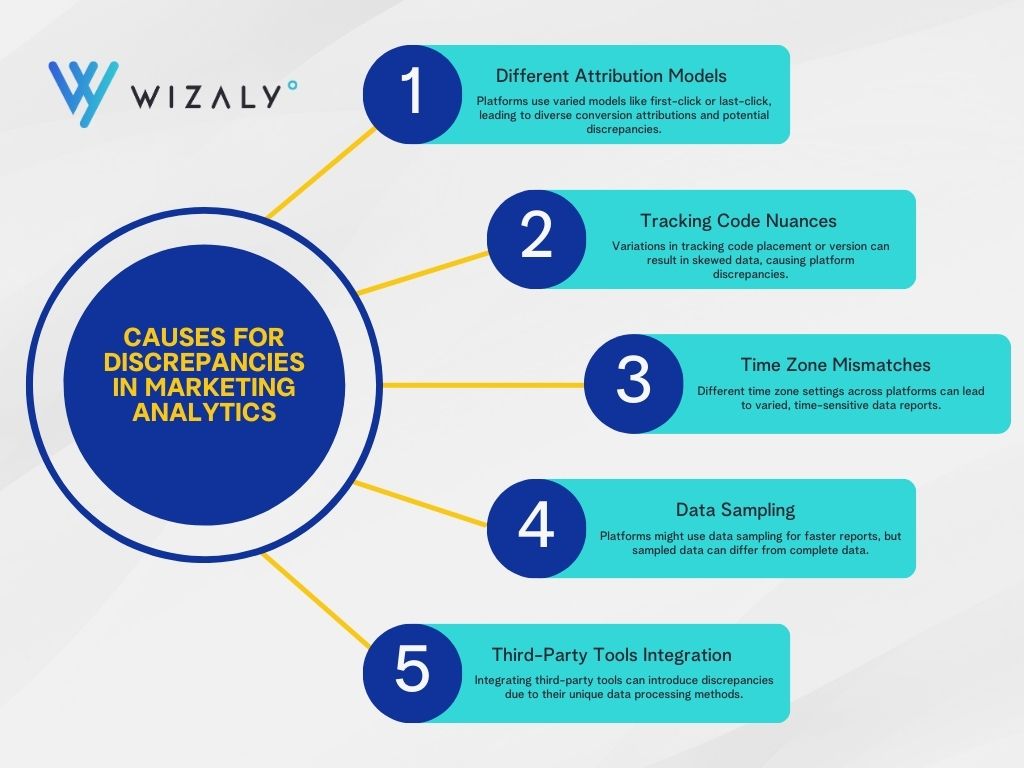Data-driven decisions are paramount in marketing so encountering discrepancies in analytics data can be both perplexing and frustrating. As digital landscapes evolve and marketing platforms proliferate, the challenge of maintaining consistent data becomes even more daunting. Have you ever found yourself questioning why Google Analytics shows a different conversion rate than your specialized mobile marketing platform? Or why the clicks reported on your Google Ad campaign differ from what’s reflected on your website analytics? Such discrepancies, while common, can lead to significant strategic missteps if not addressed. This guide aims to shed light on these discrepancies, their origins, and how to navigate them effectively.
Understanding the Nature of Data Discrepancies in Analytics
In the vast world of digital marketing, data is the compass that guides strategies, budgets, and campaigns. But what if the compass points in different directions on different platforms?
1. Diving Deeper into Analytics Platforms:
The digital realm offers a plethora of analytics platforms, from giants like Google Analytics to niche mobile marketing platforms catering to specific industry needs. Each of these platforms has its algorithms, data collection methods, and processing techniques. While this diversity offers marketers a rich tapestry of insights, it’s also a breeding ground for discrepancies. For instance, how one platform defines a ‘session’ might differ from another, leading to varied data.
2. Clicks: More Than Just a Simple Count:
At the heart of digital marketing lies the humble click. Yet, its interpretation can vary wildly across platforms. Some platforms might filter out rapid successive clicks from the same user, considering them accidental. Others might count every single interaction, leading to inflated numbers.
3. Conversions and Their Multifaceted Nature:
Conversions, often seen as the end goal in digital campaigns, can also be a source of confusion. Different platforms might have varied criteria for what qualifies as a conversion. For some, a user merely landing on a page might be enough. For others, a specific action, like signing up for a newsletter or downloading a resource, might be the benchmark.
Attribution Models and Their Impact on Data
In the world of digital marketing, understanding the customer journey is crucial. Attribution models serve as the roadmap for this journey, highlighting which touchpoints or channels were instrumental in leading to a conversion.
1. Exploring the Vast Landscape of Attribution Models:
From the straightforward first-click and last-click models to the more complex time-decay and linear models, the realm of attribution is vast and varied. For instance, while Google Ads might give credit to the last interaction before a conversion, another platform like a mobile marketing platform might emphasize the first touchpoint.
2. Multi-Platform Campaigns: A Breeding Ground for Discrepancies:
Running campaigns across multiple platforms, like Google Ads, Facebook Ads, and LinkedIn, can amplify discrepancies. Each of these platforms has its unique attribution logic, leading to potential conflicts and confusion in data interpretation.

Identifying Discrepancies in Data Collection Methods
The foundation of any analytics insight lies in how the data is collected. Different platforms have varied methodologies, which can lead to discrepancies.
1. The Intricacies of Tracking Codes:
A tracking code, often a simple piece of JavaScript, is the lifeline of data collection. However, its placement on a webpage, its triggering conditions, or even minor variations in its version can lead to significant data variations. For instance, a tracking code placed at the footer might miss out on capturing quick bounces, leading to skewed data.
2. Time Zones, Data Sampling, and Their Subtle Impact:
Something as seemingly trivial as a time zone mismatch can lead to data discrepancies. If one platform operates in PST and another in GMT, the reported data, especially time-sensitive metrics like ‘peak traffic time,’ can differ. Similarly, when dealing with vast amounts of data, platforms like Google Analytics might resort to data sampling, providing an estimate rather than exact numbers.
3. Third-Party Tools: A Double-Edged Sword:
To enhance their insights, marketers often integrate third-party tools with their primary analytics platforms. While these tools can offer deeper insights, they can also introduce discrepancies due to their unique data processing methods.

Resolving Discrepancies: Tools and Best Practices
Data discrepancies, while challenging, aren’t insurmountable. With the right tools, methodologies, and a keen eye for detail, marketers can ensure data accuracy and consistency.
1. The Quest for a Single Source of Truth:
In a world flooded with data sources, establishing a single ‘source of truth’ is paramount. This primary data source serves as the benchmark against which all other data is validated. (PS – Wizaly can be your single source of truth!)
2. The Power of Regular Audits:
Periodic data audits can help identify potential discrepancies and their sources. Tools like Google Tag Assistant, coupled with manual checks, can be invaluable in this endeavor.
3. Continuous Learning and Adaptation:
The digital realm is ever-evolving. Regular training sessions, workshops, and courses can ensure that the team remains updated on the latest best practices, reducing the chances of discrepancies.
Charting a Path Through the Data Labyrinth
In the intricate maze of digital marketing data, discrepancies can often feel like dead ends. However, with a systematic approach, a keen understanding of the underlying causes, and the right tools, these challenges can be transformed into opportunities for deeper insights and more informed decision-making.
For those seeking expert guidance in navigating this complex landscape, Wizaly stands as a beacon. With our unparalleled expertise in marketing attribution, we offer clarity, precision, and confidence, ensuring that your data-driven decisions are always on point.



